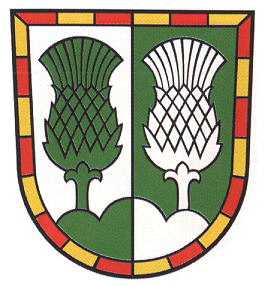Hörselberg: Difference between revisions
Jump to navigation
Jump to search
Knorrepoes (talk | contribs) m (Text replacement - "/Arms of " to "/Arms (crest) of ") |
Knorrepoes (talk | contribs) m (Text replacement - "{{media}}" to " {{de1}} {{media1}}") |
||
| Line 25: | Line 25: | ||
The municipality was created from 11 old municipalities, which are symbolised by the red parts of the bordure. As new common symbol the thistle was chosen, a typical plant on the local chalk-rich soils. The shield is divided to symbolise that the municipality is partly North and partly South of the Hörselberg, that is shown in the base of the shield. | The municipality was created from 11 old municipalities, which are symbolised by the red parts of the bordure. As new common symbol the thistle was chosen, a typical plant on the local chalk-rich soils. The shield is divided to symbolise that the municipality is partly North and partly South of the Hörselberg, that is shown in the base of the shield. | ||
{{ | |||
{{de1}} | |||
{{media1}} | |||
[[Civic Heraldry Literature - Germany|'''Literature''']]: Ulle, 1998 | [[Civic Heraldry Literature - Germany|'''Literature''']]: Ulle, 1998 | ||
Revision as of 12:37, 26 December 2022
This page is part of the German heraldry portal |
Heraldry of the World |
|
German heraldry:
|
Selected collector's items from Germany:
|
HÖRSELBERG
State : Thüringen
District (Kreis) : Wartburgkreis
Additions : 1996 Beuernfeld, Bolleroda, Burla, Ettenhausen an der Nesse, Großenlupnitz, Hastrungsfeld, Kälberfeld, Melborn, Sättelstädt, Sondra, Wenigenlupnitz
Incorporated into : 2010 Hörselberg-Hainich
| German | |
| English | No blazon/translation known. Please click here to send your (heraldic !) blazon or translation |
Origin/meaning
The arms were granted on July 27, 1998.
The municipality was created from 11 old municipalities, which are symbolised by the red parts of the bordure. As new common symbol the thistle was chosen, a typical plant on the local chalk-rich soils. The shield is divided to symbolise that the municipality is partly North and partly South of the Hörselberg, that is shown in the base of the shield.
Literature: Ulle, 1998


